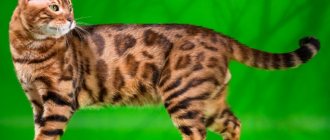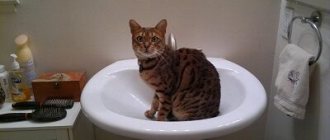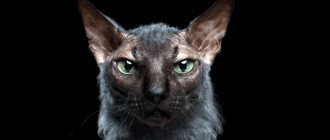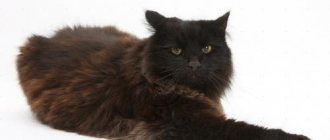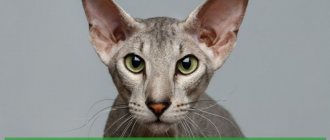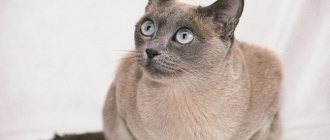Tell me, how will you react if we offer you to have... A LEOPARD in your apartment? We suspect that your first reaction will be: “This is some kind of madness! How can a leopard fit into our apartment? Flock of cats, what are you doing?
Well, such a reaction is quite predictable. However, in fact, we are not talking about a real full-size leopard, but about a small, cute cat that has a leopard color, and even has wild predators in its relatives. Surprised? Then make yourself comfortable. Today we will talk about the Bengal domestic cat.
Bengal cat: origin of the breed
Since the Bengal cat breed appeared relatively recently, in 1983, there are no mysteries or myths associated with its appearance. However, this does not mean that the history of the origin of the breed itself does not deserve the attention of an inquisitive public.
Red Bengal cat
Behind great achievements is the name of a person whose perseverance and work, in fact, led to these very achievements. And behind the emergence of the Bengal cat breed is Jane Mill, a geneticist and cat lover.
Jane, while still a student at the University of California, Davis, was seriously interested in the idea of creating new breeds of cats by crossing representatives of different breeds. However, all these ideas were cut down at the root by the university teaching staff, since, as the professors believed, they did not have any practical value. But the professor was not interested in aesthetic issues.
Bengal cat
But, despite the criticism, Jane did not give up the idea of bringing a new breed of cats. And fate heard her. One day, while on a work trip to Bangkok, Jane saw a kitten of incredible beauty at the market: big eyes, iridescent spotted fur... The girl could not resist and bought the kitten. An additional incentive for the purchase was the fact that this breed of cats, as Jane found out, was on the verge of extinction. Poachers have practically destroyed representatives of this cat breed, hunting for their valuable fur.
Waiting for Jane at home was her beloved black mongrel cat, who accepted the newly arrived kitten without any problems. The kitten, in turn, quickly became friends with the black cat. The same could not be said about people; the kitten avoided them, although it did not show much aggression.
A Bengal cat looks very organic in a home interior.
Time passed, the little kitten turned into a graceful and beautiful cat who favorably accepted the courtship of a black gentleman. And now Jane has an addition to her cat family - a cat brought from Bangkok gave birth to a kitten, who was given the name Kin-kin. The process of creating a new breed has begun!
But, unfortunately, what happened next was what is called a “plug.” Kin-kin also became pregnant and gave birth to offspring, a boy and a girl, but the babies could not retain their wild coloration. The girl got a bad temper, and the boy died. And for Jane herself, things became difficult on the personal front. And the girl decided to take a break from working on a new breed of cats.
Jane Mill returned to breeding work already in the 1980s, thanks to a gift given to her by Dr. Willard Centerwall, an employee of Loma Linda University. Mr. Willard was the leader of a project to study such a terrible and deadly disease as leukemia. In the process of work, it was possible to breed offspring of the Asian Leopard cat, which received immunity to leukemia. And it was the kittens from this litter that Dr. Willard gave to Jane to continue the breeding work.
How can you get such beauty off the table?
Before continuing to work with the breed, Jane had to solve one more problem: what breed should the Asian Leopard be crossed with? She understood that popular cat breeds had defects that could have a negative impact on a new cat breed. So, Jane dismissed such options as British, Persian and Abyssinian breeds. But who is suitable then?
Jane brought the answer back from her trip to India. There, in the city of New Delhi, Jane saw a kitten with amazingly beautiful golden fur and a spotted pattern. She later learned that it was an Indian offshoot of the Egyptian Mau breed. So the problem of finding a breed to cross was solved and the work began to boil. In 1983, the Bengal breed was registered with the TICA organization and received well-deserved recognition.
Today, breeders continue to work hard on the Bengal cat breed. They correct problems with color and coat length, and correct behavior.
Relaxed Bengal
The Bengal cat breed appeared in Russia in 1997. We wouldn’t dare call it an “expensive breed”, just like calling it “free”. The price for a Bengal kitten starts from $300.
Forbidden food for Bengal kittens
Despite the fact that representatives of the Bengal breed are not prone to gluttony, they, like all cats, are curious and can beg their owner for delicacies that interest them. But the following foods are prohibited for kittens:
- cow's milk;
- fatty (and raw) meat: beef, turkey, duck, pork;
- bones of any kind;
- River fish;
- vitamin complexes for people;
- “human” dishes: roasts, soups, stews, salads;
- peas, beans;
- any sweets;
- flour;
- fruit seeds;
- fresh tomatoes and potatoes;
- garlic/onion.
Babies should be fed at the same time every day. If it is difficult for a kitten to chew dry food, it should be soaked in water or skim milk. Feed granules that are too large must be crushed. It is better not to mix dry food with natural food: in order to digest these different types of food, the cat's stomach produces different enzymes. Any failure can lead to indigestion and unpleasant consequences.
Bengal cat: breed standards
The main feature of the Bengal cat is its color, which is why experts place special emphasis on color. This does not mean that everything else that nature has endowed a cat with does not have a classified standard, but color is put at the forefront. This is understandable: for the sake of this bright wild color, this huge front of breeding work was done. But let's go in order:
- Head: Wedge-shaped, with a large nose and almond-shaped eyes that can be gold, blue or green. Due to the wedge-shaped head, Bengals' ears are set high. The ears themselves are wide at the base and rounded at the tips.
- Body: elongated and proportionately muscular, larger than average in size. The Bengal's height at the withers reaches up to 32 cm. The length of the body reaches 100 cm (from the nose to the tip of the tail).
- Limbs: muscular, of medium length. The paws are large and rounded. The tail is thick at the base and rounded at the tip, and is of medium length.
- Coat: short, thick, lying close to the body. The Bengal's coat is very soft and silky to the touch. It has an unusual internal shine, which is called “glitter,” inherited from its wild ancestors.
Small domestic leopard
Weight of a Bengal cat: from 4 to 6 kg. Bengal cat weight: from 5.5 to 9 kg.
Bengal cat: colors
The main requirement for the color of the Bengal cat breed is that the black or brown pattern must be clearly visible. Speaking about the color of the Bengal cat breed, it is necessary to highlight two branches: the color of the cat and the pattern of spots. Let's look at these two points separately:
Nice in the countryside in summer
Colors
Bengals have five colors:
- Golden. The most popular color, found in most representatives of the breed.
- Silver. Second most popular.
- Snow. It occurs much less frequently. Kittens born with this color are born without patterns and spots on their fur coat, but with age the pattern appears.
- Coal, aka black.
- Blue.
The last two colors are incredibly rare.
Spot patterns
Rosette spots
Basic patterns of spots:
- Marble (horizontal contrasting stripes);
- Rosette (dark spot with contrasting edging);
- Spot (contrasting dark spot).
Kitten weight table by age
The size of a Bengal kitten reflects its health. Cubs with congenital defects, parasitic diseases, genetic abnormalities, and those with poor nutrition develop poorly.
To promptly identify deviations from the standard, the owner must weigh the kitten regularly. In the first weeks of life, weighing should be daily, then twice a week.
The normal weight of a Bengal kitten at different stages of life is shown in the table.
| animal age, months | average normal body weight, kg |
| first week after birth | 0,08–0,12 |
| 1st month | 0,4–0,5 |
| 2–3 | 0,8–2,4 |
| 4–5 | 2,7–3,6 |
| 6 | 3–3,8 |
| 7 | 4 |
| 8–9 | 4,2–6 |
| 10–12 | 4,5–6 |
A newborn Bengal kitten weighs 80–120 g, but after a week this figure doubles.
Recommendation! If a newborn kitten feeding on mother's milk is not recovering well, then the nursing cat should be given more protein and vitamin food.
The kitten is gaining weight unevenly. Once the baby reaches 2 months of age, its growth slows down. But as soon as its weight exceeds 1 kg, development becomes rapid again. By 7–9 months of age, body development and mass accumulation are once again inhibited.
In females, growth acceleration is no longer observed; body size remains almost unchanged. But males resume active development until 2 years of age.
Bengal cat: health
The diligent work of breeders has borne fruit - the Bengal cat breed has excellent health. This is also evidenced by the life expectancy of Bengal cats - 14-16 years, and this is not the limit. Among the Bengal breed there are long-livers who have passed their second decade. Here, as always, a lot depends on the attentiveness and care of the owners.
Young Bengal cat
However, it is not without predispositions to certain diseases:
- Feline leukemia. The irony of the situation is that the breed was originally created to study feline leukemia. But, alas, it was not possible to rid the Bengal cat breed of this disease.
- Hypertrophic cardiomyopathy.
- Problems with the digestive system.
Figurine
If you regularly take your cat for examinations to a veterinary clinic, then most health problems can be identified at an early stage and treatment can begin on time. Annual vaccination will also have a positive effect on your pet's health.
The digestive system of Bengals is worth talking about separately. Agree, it’s a strange thing: to buy a kitten for $300, and at the same time feed it with cheap food. If the owners decide to save on food for their expensive (in every sense) pet, then as a result they will get a constantly vilified cat with a depleted body. So the diet of Bengal cats should consist only and exclusively of holistic food. Moreover, you should not feed only dried food, or only canned food. The best way to feed a Bengal is to dilute the dry food with canned food a couple of times a week.
Hunting season is open
In addition to proper nutrition, do not forget about the cat’s free access to drinking water. However, owners of the Bengal cat breed have noticed that Bengals flatly refuse to drink water from a bowl, even if fresh water is poured. Breeders attribute this to the instincts that domestic Bengals inherited from their wild ancestors: drinking standing water can be dangerous. Yes, Bengal owners should seriously consider a drinking fountain for their pet. Well, or give it water from the tap, preferably filtered.
Well, if you decide that your pet deserves more, and he will only eat food prepared by you, then do not be too lazy to first consult with a doctor at a veterinary clinic. Based on the tests, he will help you create a diet for your cat, and at the same time tell you what vitamins he should be given in addition to those he will receive with food.
I'm observing from a tactical heights
When you reach puberty, which usually begins at the age of 6 months, you should think about spaying or neutering your cat. However, if you are planning to become a breeder and breed Bengal cats, we strongly recommend that you consult with existing breeders and nurseries that breed Bengals on a professional level.
Bengal cat and allergies
You can find many references online that the Bengal cat breed does not cause allergies. This is not entirely true. In fact, many people who are susceptible to allergic reactions have reported that when interacting with the Bengal cat breed, they did not experience an allergic reaction. It was assumed that the whole point was the short hair of this cat breed.
Bengal kittens
In fact, allergies manifest themselves not only and not so much because of fur, but because of Fel D1, a protein produced by the sebaceous glands of the cat. And Bengal cats actually produce much less of this protein than cats of other breeds. But do not forget that, in addition to this protein, an allergic reaction can also occur due to:
- odor of urine and feces;
- salivary glands;
- just wool (for particularly sensitive allergy sufferers);
- the smell of cat food.
Therefore, do not rely on chance. Before you bring a cat into your home, no matter what breed, do an allergy test. And don’t forget about the rest of the preparatory work.
Why you can’t pick up a kitten early
The desire to take a new pet home as soon as possible is understandable, but pursuing it is dangerous. Yes, there are irresponsible sellers who are ready to give an eight-month-old kitten to a new owner, but a responsible breeder will never allow him to be taken away from his mother and brothers and sisters so early.
From six to twelve weeks of age, the kitten continues to develop mentally, emotionally, physiologically and psychologically. For normal development, he needs to stay with his mother and other kittens. Early weaning will cause stress, which can significantly worsen your pet's condition.
The kitten’s immunity at this stage is very vulnerable, since the innate “margin of safety” has already been depleted, and the ability to resist diseases after the first vaccination is still developing. In a nursery, the likelihood of encountering new diseases is minimal, but it increases when moving to a new home.
Colds and bowel problems are especially dangerous at this time. Vaccination and the formation of new immunity under familiar conditions protect well against possible diseases. The kitten is not yet physically strong; the stress of moving often turns out to be an excessive burden on a weak body.
The transition from breastfeeding to solid food occurs gradually. At eight weeks, the kitten is still at the beginning of this journey. By the twelfth week he is completely ready to eat ready-made food. It is the mother cat who teaches the kitten to cope with the disappointment of lack of milk. She is nearby, ready to caress him. The stress on the psyche is reduced, and the risk of behavioral problems in the future is minimal. The breeder accustoms the kitten to being held.
Digestion will be much better if the new owner follows the breeder's recommendations for feeding the pet. Switching to a new type of diet can cause diarrhea. Diarrhea causes dehydration and poses a danger to your pet. Breeders always know how to take care of a kitten in such a situation, but new owners almost never do. The ability to use a litter tray develops around 10-12 weeks. A two month old kitten is too young to learn this skill.
“Keeping a purebred kitten for an extra month is not cheap. If the seller willingly gives away a pet at two months, he is more interested in profit than in the successful development of the little Bengal. It’s better to refuse a dubious deal and turn to a breeder with a good reputation.”
A kitten without documents, but with a similar color, may cost less than that of a breeder, but it may not even be a Bengal, but a hybrid from a random mating. His health, upbringing and ability to learn are in big question. A well-mannered Bengal cat is not aggressive. He can be trained to use a regular toilet; he understands that a person’s arms and legs are not a toy.
Do not be afraid that at three months a kitten is less affectionate than at eight weeks. On the contrary, the stress of early relocation and separation from mother, illnesses that are almost certain to occur, can make adaptation difficult. A healthy and developed pet has the strength and opportunity to calmly explore a new place and fall in love with its new family.
If there are other animals in the house, socializing the cat before 12-14 weeks is even more important. During this period, the kitten acquires communication skills with other kittens and adults. The ability to calmly communicate with people and not be afraid of them is also formed at this time. The correct timing for moving eliminates problems for both the owner and the little Bengal.
The new owner can learn a lot of useful information from the breeder: what to feed, how to properly care for them, trim their nails and wean them off bad habits if they appear, how to distinguish the first signs of illness, calm them down, clean their ears, when to vaccinate, etc. It should be remembered that runners always live in an apartment and need space to play. A kitten worth several tens of thousands of rubles should not walk on its own. A curious and active pet can run away in just a minute.
Bengal cat: care and maintenance
We wrote in detail about the nutritional habits of Bengals in the section on health. Otherwise, the Bengal cat breed is one of the most undemanding cat breeds to care for:
That is why it is simply necessary to install Anti-Cat screens on windows
- Combing: once a week with a soft brush;
- Nail trimming: once a week;
- Inspection and cleaning of ears: once every couple of weeks;
- Examination and cleaning of teeth: once every couple of weeks;
- Bathing: after every walk or if there is heavy dirt that the cat cannot remove from the fur on its own. Bengals love water, so washing the cat does not present any problem for the owner.
- Horizontal and high vertical scratching posts are required. The cat should have all the conditions for a claw point, and the owners should have all the furniture, so everyone wins.
- Walking down the street. An active life position will not allow Bengal to sit still. And walking down the street with your beloved two-legged cat (even on a harness and leash) will be an excellent reason for the cat to release pent-up energy, and at the same time pick up new impressions and unfamiliar smells.
Bengal cat: character and behavior
Young Bengals are active, nimble and very playful. They love to rush around without really understanding the road, demolishing everything in their path, climbing into secluded corners, exploring all available hills. And this is not surprising: this is the most natural way for a cat to understand the world around him, and at the same time learn the limits of what is permitted.
Bengal kitten
If you are afraid that the breeder may slip you a wild Bengal, then we strongly recommend that you read our article about how to choose the right breeder. The recommendations in this article also apply to choosing a Bengal kitten.
You should start raising a Bengal right away, without putting it off for a long time. And Bengal will be happy to join this process. All thanks to the intelligence and insight that nature has given to this breed. Bengal perfectly captures the intonations with which people address him, and reads dissatisfaction if his prank has gone too far. And he rejoices at the affectionate intonations when the cat did everything right. So you should communicate with Bengal by voice as often as possible, and he will answer you in the same way. After a while, you will get used to this kind of conversation and will easily understand what the cat is trying to tell you.
The cat is sneaking around.
Bengals communicate well not only with people, but also with other animals in the house. Because of their character and developed intelligence, Bengals often become great friends even with large dogs, arranging joint games with them. But small pets (mice, rats, hamsters, fish...) are much less fortunate. The developed hunter instinct of the Bengal cat breed will not leave them any chance, so take this point into account.
But Bengals are friendly towards people, without showing any aggression. Even to children. If a child crosses the line of what is permitted and overdoes it with squeezing the cat, then Bengal, in the worst case, will hiss at the child. He won't use his teeth and claws. Although usually it all ends with going to a quiet place where a human child cannot disturb Kitty (on a closet, for example).
Miniature domestic leopard Bengal
is wary of strangers in the house and often shows hostility. Yes, this is his territory, and he is ready to fight for his territory. However, if you warn the guests in advance so that they do not grab the cat, but let him get used to the guests, then after a while the cat will come out to say hello. And maybe, if the guests behave well, he will allow them to pet him.
Bottom line
Of course, the Bengal cat breed is not suitable for everyone. These are active and lively cats that need to be played with and raised. This is absolutely not a sofa breed of cat, like the Persian. It is advisable to go for walks with Bengals, which not everyone can afford.
When everything is fine with you
But if all of the above is not a problem for you, then there is not a single reason to dissuade you from purchasing a Bengal. The main thing is that before purchasing, make sure that you have read all the information and that it will not come as a surprise to you, for example, that the Bengal breed is sociable or active.
